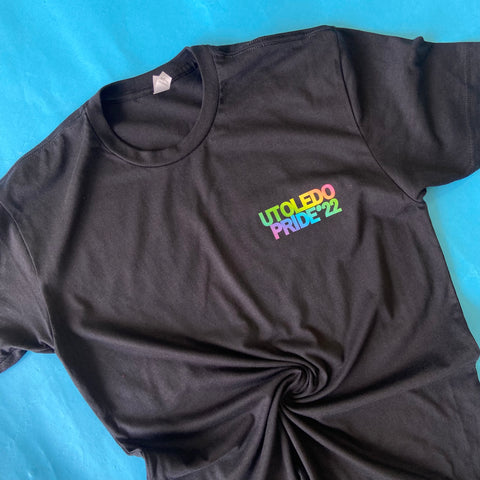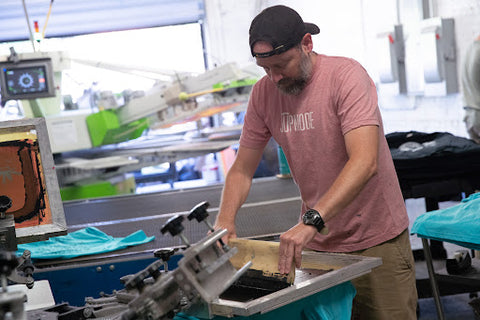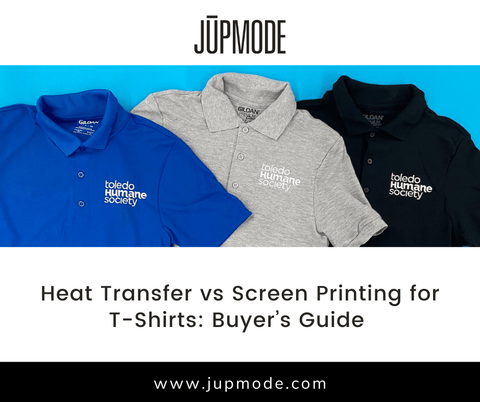Custom t-shirt printing is a great way to stand out and remain fashionable.
From statement pieces to charming designs, custom t-shirt printing has become the solution for not only the fashion business but also the construction, warehousing, and landscaping industries.
If you’ve been looking to buy custom t-shirts, you may have noticed two types of printing: heat transfer and screen printing.
But which one is better?
While both methods involve the transfer of an image or pattern onto fabric, they have a lot of differences.
For instance, if you just want a quick and easy way to create a stylish T-shirt, heat transfer printing may be the best option. However, if you want a high-quality print that will last a long time, screen printing is the way to go.
Whichever method you choose, read through our buyer’s guide to get all the information you need before making a purchase.
What is a Heat Transfer?
Heat transfer involves using a heat press to apply both heat and pressure to imprint designs onto fabric.
The design is first printed onto high-quality paper before being positioned and pressed into a garment.
The following steps are involved in the heat transfer process:
- Creating a design on a computer: Graphic design software is used to arrange and model the text and images to be printed.
- Printing the design: Inkjet, sublimation, screen print, or pigment ink is then used to print the design onto heat transfer paper, which is responsible for transferring the printed design onto a t-shirt.
- Trimming the printed image: If necessary, a vinyl cutter is then used to trim the image edges. Any part that’s not cut away will show up on the final product.
- Warming up the heat press: In most cases, the temperature should be in the range of 340°F to 365°F (171°C to 185°C). Your transfer supplier will provide heat and pressure settings.
- Adjusting the pressure: The pressure will vary depending on a fabric’s thickness. As a rule of thumb, the thicker the material, the lighter the pressure.
-
Setting the time: Different methods of heat transfer correspond to different press durations. Here’s a general guide for timing the heat press machine:
-
- Vinyl Transfer: 7–15 seconds
- Digital Transfer: 10–20 seconds
- Dye Sublimation Transfer: 25–30 seconds
-
- Positioning the substrate and transfer: The t-shirt is placed onto the platen, and the heat transfer paper is set face-up on the appropriate location of the t-shirt.
- Pressing the product: Once in place, the handle is pulled down on the press to close it.
- Removing the film: When the timer goes off, the heat press is opened and the film is taken out.
Let's now look at the two main heat transfer methods used in this process: Vinyl and Digital Transfer.
Vinyl Heat Transfer
Vinyl heat transfer or heat transfer vinyl (HTV) is a material that adheres to surfaces like fabric when heat is applied. Vinyl comes in thin sheets made from polyurethane.
HTV has a heat-activated adhesive backing to ensure the vinyl easily transfers to t-shirts when the machine is pressed at the right temperature and pressure.
Digital Heat Transfer
This is similar to printing a photograph onto a garment. However, digital heat transfer uses regular transfer paper instead of vinyl transfer paper.
When the transfer paper is pressed, the ink adheres to the garment, and the graphic image is transferred.
Here are the pros and cons of heat transfer:
| Pros | Cons |
| Environmentally friendly and minimizes carbon footprint | Doesn't last as long as traditional screen printing because of washing and drying |
| Produces high-quality products due to its high resolution | You can’t iron the printed t-shirt because the heat ruins the image |
| Cost-effective for small orders due to the short set-up process | Has a rubbery feel due to the printer ink coverage on the design |
| Can utilize multiple colors as long as they don’t overlap | Unsuitable for printing many units because large quantity runs are time-consuming and expensive |
What Is Screen Printing?
Also known as silk screening, screen printing involves pressing thick ink through a mesh screen to transfer graphics onto a garment. Rather than laying on top of the fabric, the ink soaks into the garment and becomes part of it—ensuring it lasts longer.
Although t-shirts are the most commonly screen printed clothing item, here are other popular screen printed garments:
- Long sleeve t-shirts
- Crew sweatshirts
- Hooded sweatshirts
- Tank tops
- Onesies
The Screen Printing Process
The following is a quick step-by-step screen printing procedure for t-shirt printing.
1. Creating the Design
The process starts by taking the design and converting it to vector format. This allows us to scale the design to the appropriate size for printing. When necessary, the design can also be hand-drawn.
2. Preparing the Screen
A mesh screen (made of silk, polyester, or nylon) that suits the texture and design is chosen. The screen is coated with light-reactive emulsion to be prepared for exposure.
3. Exposing the Emulsion
The emulsion-coated screen is then exposed to bright light to harden it, usually in an exposure unit. A screen must be made for each color and each location of the print. Check out the video below on how we burn screens for making t-shirts.
4. Rinse Out the Screen
After exposure, the light hardens the emulsion such that other screen parts (those not covered by the design/image) are hardened while those covered by design are soft enough to wash away. After a set time of about one minute, the screen is washed to reveal the design. It’s then left to dry to create the stencil.
5. The Actual Printing
The screen is fixed onto a special screen printing board or platen, and ink is added to the screen's top (or one end). A squeegee is then used to pull the ink across the screen. This process pushes the ink through the stencil, imprinting the design on a t-shirt.
6. Dry, Quality Check and Finish

The printed t-shirt is passed through a dryer to cure the ink and ensure it remains smooth before being checked and washed to remove any residue.
| Pros | Cons |
| A cost-efficient method because it can print large quantities pretty fast | Limited to a few colors because you’ll need a screen for each color to be printed |
| Creates a softer product compared to heat transfer because the ink penetrates the fabric | Expensive when not in bulk due to the initial setup cost |
| Produces bright and vivid final products, even on dark fabrics | Uses more equipment and chemicals than heat transfer, which are responsible for the vivid colors |
| Perfect for printing onto polycotton or cotton clothing items | |
| Results in long-lasting and more durable designs |

Deciding Between Heat Transfer and Screen Printing
Your individual needs will largely determine the printing method you choose. Do you want a t-shirt with high-resolution designs that last a few days or better quality t-shirts that last a long time?
Screen printing is still the most popular technique because it produces vibrant, durable patterns on various materials. However, it doesn't give you the freedom to have sophisticated or multiple color images on your t-shirt like heat transfer printing.
So, Which Printing Method Is the Best?
Without a doubt, each of these printing processes brings something distinct to the table. Consider answering these questions to decide between the two:
Q1: Do the t-shirts require complex designs?
If so, consider heat transfer at smaller quantities.
Q2: Do you have a strict budget to stick to?
If you are price sensitive, a transfer can save you setup fees, thus keeping your costs lower.
Q3: How many t-shirts do you want to order?
There is nuance to this, but we generally screen print orders of 25 pieces or greater. Orders of higher quantities with more complex designs are easier to justify the setup associated with screen printing.
Q4: Does your design require unusual placement or multiple different garments and fabrics?
If you are printing in an unusual location, such as on a pocket, we may recommend a transfer. These odd locations may make it difficult to place and secure a garment on a printing board. If we cannot print consistently, it will be better to use a transfer.
If there are many different garments and they are a mix of fabric materials (100% cotton, polyester, spandex, etc.), a transfer will provide the most consistent decoration across all clothing items.
Q5: Do you require on demand printing services?
It's more and more common today for customers to request print on demand. Because of the setup associated with screen printing, transfers can provide an effective method for providing on demand decoration services.
Note: While you can quickly print one or two t-shirts using the heat transfer, it’s much faster to print using screen printing once the setup is complete.
Still not sure?
Get in touch with us and one of our representatives will help you select the best printing method for your t-shirts. You can also check out our blog for more information about t-shirt printing and custom embroidery.
Share on Facebook:

















Comments
Hi,
I am a store manager of a souvenir shop where most of our items are custom made. We have 39 statues in our town and I am looking to get a shirt designed with all the statues. Would like the first one in the middle with the rest going round in a circle. I have the statues in a jpeg without backgrounds. Any suggestions?
Thanks
Mary Ann
Write a comment